Watching the Eclipse Across America
Daniel Hautzinger
August 18, 2017

It's been almost four decades since the last one, and another won't happen until 2024: the first total solar eclipse to pass over the lower 48 states since 1979 is a big deal – you don't want to miss it. Here in Chicago we'll experience 87% totality, while a swath of the country from Oregon to South Carolina will see the sun completely covered by the moon. PBS stations across the country are offering immersive coverage of the utterly unique phenomenon – explore some of the plans here. If you're planning on viewing the eclipse, make sure to check out safety tips from an ophthalmologist and an expert from the Adler Planetarium, who also offers fun facts.
Chicago
The eclipse will be visible in Chicago from 11:54 am to 2:42 pm here, with maximum coverage at 1:19 pm. Chicago Tonight will be broadcasting live on our Facebook page from the Adler Planetarium's Eclipse Fest block party around 11:45 am. Eddie Arruza will talk to scientists from the Adler while observing the festivities, then debrief the eclipse with the Adler's experts during Chicago Tonight's broadcast at 7:00 pm. An Adler astronomer will give a report during the broadcast from Carbondale in southern Illinois, near the longest point of totality; a Field Museum expert will also share the history of human reactions to eclipses across the centuries. Alex Ruppenthal reports on the reactions of animals at the Lincoln Park Zoo. Watch NASA's live-feed of the eclipse on WTTW's homepage, and explore more digital stories here.
NOVA
NOVA is producing a show with its quickest ever turnaround – Eclipse Over America will feature footage of the eclipse from across the country, and be broadcast the same day, at 9:00 pm. The science show is also partnering with NewsHour for a Facebook Live hosted by Miles O'Brien from Idaho.
Carbondale
Located right near the longest point of totality – around two minutes and forty seconds – Carbondale and Southern Illinois University are expecting some 50,000 people to travel there to view the eclipse. WSIU will broadcast five hours of live coverage, while its radio program Planetary Radio will host a live show. The university even cancelled classes to allow students, faculty, and staff to join in the festivities and see the phenomenon.
Oregon
OPB in Oregon, where the eclipse first passes over the U.S., has been covering the eclipse for weeks, from how small towns are preparing to receive thousands of visitors to tips from eclipse-chasers. Both the radio and TV stations will be covering the eclipse, and the TV station is aiming to send footage to NOVA – that is, if all goes well with traffic. There's a wildfire on the highest point in the path of totality, Mount Jefferson, so no one can view the eclipse from there. But OPB will also be covering the aftermath of the eclipse and its effect on the economy and public lands.
Nebraska Bill Nye provides commentary on the eclipse from Nebraska.
Bill Nye provides commentary on the eclipse from Nebraska.
Bill Nye, who is CEO of the Planetary Society as well as the Science Guy, will be at Homestead National Monument in Beatrice, near Lincoln (which also experiences totality) on the day of the eclipse to provide commentary, but events around the eclipse will occur all weekend. The PBS station is also taking 360 degree cameras out across the state to cut together immersive video coverage.
South Carolina
The state's ETV will broadcast live footage of the eclipse and talk with astronaut Charles Duke for commentary.
More Livestreams
Want to follow the eclipse across the country? In addition to those already listed, Wyoming and Tennessee PBS stations will feature live footage of the eclipse on their websites and/or Facebook and Youtube.







